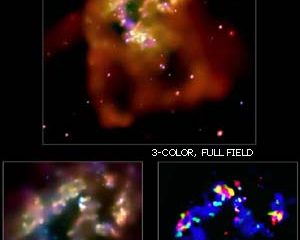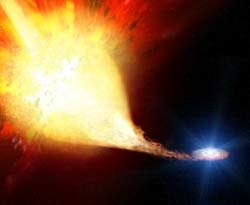Physics and Astronomy
This area deals with the fundamental laws and building blocks of nature and how they interact, the properties and the behavior of matter, and research into space and time and their structures.
innovations-report provides in-depth reports and articles on subjects such as astrophysics, laser technologies, nuclear, quantum, particle and solid-state physics, nanotechnologies, planetary research and findings (Mars, Venus) and developments related to the Hubble Telescope.

Physicists have helped discover a new state of matter that may shed light on the fabric of the universe
The University team of 14 is part of a group of 300 physicists from 13 countries known as the ‘Belle collaboration’. They have discovered a sub-atomic particle that they are having difficulty explaining and difficulty fitting with any current theory that attempts to describe matter.
Their research will be published in Physical Review Letters (in press).
“It could mean some of the standard and accepted theories on matter will need to be modified to incorporate some new physics,” sa

First-known Double Pulsar Opens Up New Astrophysics
An international team of scientists from the UK, Australia, Italy and the USA have announced in today’s issue of the journal Science Express [ 8th January 2004 ] the first discovery of a double pulsar system.
They have shown that the compact object orbiting the 23-millisecond pulsar PSR J0737-3039A with a period of just 2.4 hours is not only, as suspected, another neutron star but is also a detectable pulsar, PSR J0737-3039B, that is rotating once every 2.8 seconds.
Professor A

Astronomers see era of rapid galaxy formation
New findings pose a challenge for cold dark matter theory
“The universe is always more complicated than our cosmological theories would have it,” says Nigel Sharp, program officer for extra-galactic astronomy and cosmology at the National Science Foundation (NSF). Witness a collection of new and recently announced discoveries that, taken together, suggest a considerably more active and fastmoving epoch of galaxy formation in the early universe than prevailing theories had called for.

Mars Express: no signal from Beagle 2 so far
ESA’s Mars Express orbiter made its first attempt to establish contact with the Beagle 2 lander, after the two spacecraft separated on 19 December 2003.
The orbiter made its first pass over the Beagle 2 landing site today at 13:13 CET, but could not pick up any signal from the tiny lander. More attempts to contact Beagle 2 are planned in the days to come.
Beagle 2 was released on 19 December on a course towards the Red Planet by Mars Express, the mothership for the 400 million kil

Chandra locates mother lode of planetary ore in colliding galaxies
NASA’s Chandra X-ray Observatory has discovered rich deposits of neon, magnesium, and silicon in a pair of colliding galaxies known as The Antennae. When the clouds in which these elements are present cool, an exceptionally high number of stars with planets should form. These results may foreshadow the fate of the Milky Way and its future collision with the Andromeda Galaxy.
“The amount of enrichment of elements in The Antennae is phenomenal,” said Giuseppina Fabbiano of the Harvard-Smi

First supernova companion star found
A joint European/University of Hawaii team of astronomers has for the first time observed a stellar ‘survivor’ to emerge from a double star system involving an exploded supernova.
Supernovae are some of the most significant sources of chemical elements in the Universe, and they are at the heart of our understanding of the evolution of galaxies.
Supernovae are some of the most violent events in the Universe. For many years astronomers have thought that they occur in either solitary